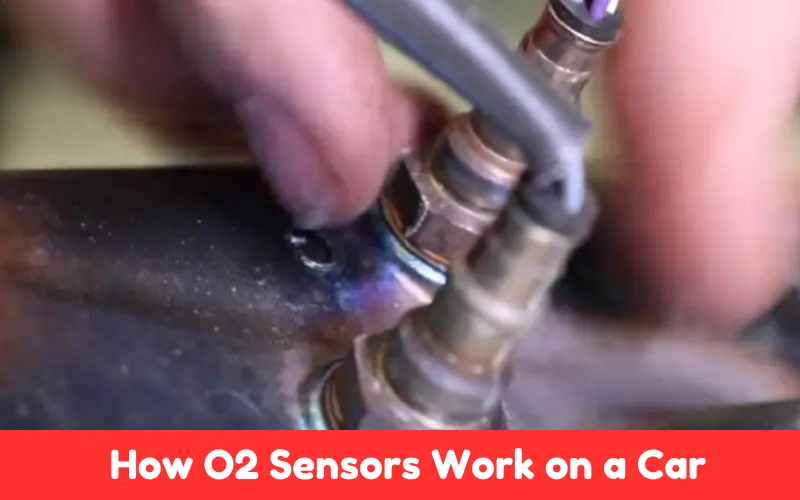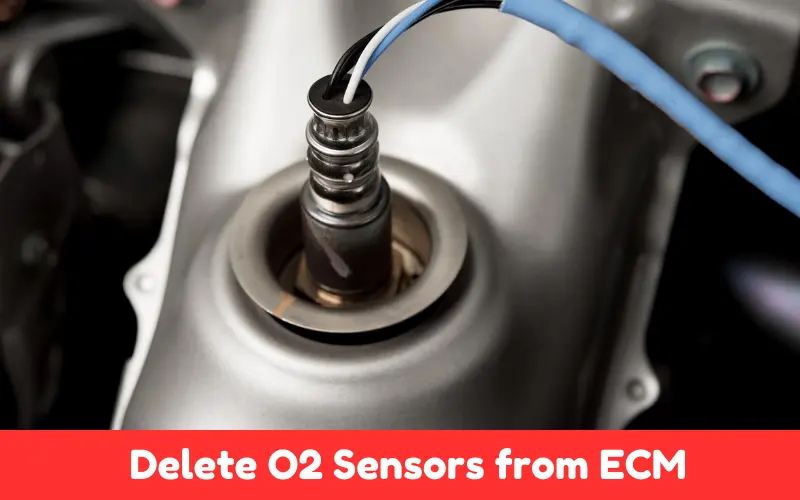The oxygen sensors or O2 sensors, are a part of the automobile emissions control system that detects the amount of oxygen in exhaust emissions and communicates it to the ECM.
If you want know how to delete O2 sensors for ECM then you have to know the advantages first. The ECM regulates the air-fuel mixture to obtain maximum power and the least emissions.
Oxygen sensors or O2 sensors, placed on the exhaust of every carbureted car are part of that car’s emissions control system. They monitor the air-fuel mixture coming into the engine and adjust it to run smoothly, cleanly, and efficiently.
Article Summary
- What Are Car O2 sensors?
- Types of Car Oxygen Sensors
- How O2 Sensors Work on A Car?
- Common Issues and Maintenance of A Car O2 Sensors
- Why Delete Car O2 Sensors?
- How To Delete O2 Sensors from ECM
- Final Checks
- Potential Risks of Deleting Car O2 Sensors form ECM
- FAQs about Deleting O2 Sensors from ECM
- Conclusion
What Are Car O2 sensors?
Oxygen sensors are found in the exhaust system before and after the catalytic converter. Their role is to provide feedback on the amount of oxygen in the exhaust gases and send that information to the ECM, which then alters the air-fuel mix to promote the ideal blend. This blend is important because:
Fuel Efficiency: Increasing the proportion of air and lowering the proportion of fuel can significantly increase fuel efficiency and reduce total fuel consumption.
Air-Fuel Ratio: Having a good air-fuel ratio aids in smooth engine performance and better fuel economy.
Emission Control: Keeping the air-fuel mixture within safe limits stops the release of pollutants into the atmosphere.
Types of Car Oxygen Sensors
There are mainly two types of O2 sensors:
Pre-Catalytic Converter O2 Sensors: These sensors monitor the level of oxygen present in exhaust gases directly from the engine before the exhaust gases enter the catalytic converter.
After Catalytic Converter O2 sensors: These are placed downstream of the catalytic converter to check the effectiveness of the converter in cleaning the exhaust gases.
How O2 Sensors Work on A Car?
The oxygen sensor produces a voltage based on the difference of oxygen between the exhaust gases and outside air and sends the voltage signal to the ECM that interprets it.

Then, the output adjusts the amount of air-fuel mixture. If the mixture for combustion is too rich, the voltage becomes high. If, for some reason, there is too little fuel supplied to the mixture, the voltage remains low.
Based on the voltage signal, the ECM makes precise adjustments to the air-fuel mixture in real-time so that the engine operates efficiently.
Common Issues and Maintenance of A Car O2 Sensors
Oxygen sensors can wear out or fail over time, leading to several issues:
Poor fuel economy: When the engine runs too lean or too rich due to a faulty O2 sensor, accelerated fuel consumption results.
Increased pollutant: Due to the improper air-fuel consumption ratio, pollutant emission tends to rise.
Check engine light: Check engine light on car dashboard is also triggered for Oxygen sensor malfunction.
Regular maintenance and timely replacement of car’s O2 sensors will ensure your vehicle continues to run correctly and will not be in violation of your state’s emissions standards. Most vehicles should be inspected every 60,000 to 90,000 miles.
Why Delete Car O2 Sensors?
There are a couple of reasons why vehicle owners may decide to delete O2 sensors. In aftermarket high-performance vehicles, deleting spherical-tipped oxygen sensors can help a vehicle’s tuner achieve certain goals.
Some higher-quality aftermarket exhaust systems cannot be used with O2 sensors. Some vehicle owners, especially those who live in poorly maintained road conditions, have experienced repeated O2 sensor failure and may decide to delete the O2 sensor instead of replacing it.
How To Delete O2 Sensors from ECM
As a general warning, it is illegal to remove O2 sensors in most places under emissions regulations; always check local regulations before proceeding.
1. Gather Necessary Tools and Equipment
Prior to beginning your work, gather all of your tools and equipment, such as an OBD-II scanner, ECM software for tuning, wiring tools, and resistors (if needed).
2. Disconnect the Battery
Before starting any work, disconnect the vehicle’s battery to ensure safety.
3. Access the ECM
Find your vehicle’s ECM (electronics control module, more commonly called the engine control module). It is typically located under the dash or in the engine bay.
4. Use an OBD-II Scanner
Connect an OBD-II scanner to your vehicle’s diagnostic port and read/clear any existing codes for the oxygen sensors.
5. Modify Car ECM Software

Use ECM tuning software to change the ECM settings. This allows you to turn off the O2 sensor inputs. Examples of ECM tuning software include HP Tuners, EFILive, and SCT.
6. Bypass the O2 Sensors Physically
As a pinch hitter, if you have to, add resistors in place of the oxygen sensors so the ECM doesn’t sense a missing sensor.
7. Reflash the ECM
After all of this, flip the ECM back and reflash the ECM with the software you edited. This makes the ECM ignore the O2 sensor signals.
8. Reconnect the Battery
Once all modifications are complete, reconnect the vehicle’s battery.
Final Checks
Turn on the engine and let it idle for a few minutes. Check for the check engine light and saved error codes (if your model has one—it won’t on all older models). Go for a test drive, making sure it runs smoothly and no issues occur because you no longer have an O2 sensor.
Potential Risks of Deleting Car O2 Sensors form ECM
This works because there are technical legal requirements regarding the installation of new parts in a vehicle, and removing O2 sensors could breach some of those technical requirements (so, for example, if your vehicle fails an emissions test, it could affect your license renewal).
Furthermore, removing O2 sensors could affect engine performance and fuel efficiency, which could also void your vehicle’s warranty.
FAQs about Deleting O2 Sensors from ECM
What are O2 sensors, and why are they important?
O2 or oxygen sensors are part of a vehicle’s emissions control system, and they are used to determine the amount of oxygen in the exhaust gases. The ECM analyzes the information from the O2 sensors and uses the data to adjust the air-fuel mixture for maximum engine performance and reduce emissions.
Why would someone want to delete O2 sensors from the ECM?
There are a few reasons to delete your car’s O2 sensors. For cars that are highly tuned for performance, deactivating the O2 sensors can serve as an endpoint for engine tuning. Some aftermarket, or ‘race pipe,’ exhaust systems are made to fit on the car without O2 sensors present. For O2 sensors that are prone to premature failure, deletion could be an alternative to paying for and installing new sensors.
Is it legal to delete O2 sensors from my vehicle?
Depending on where you live, removing your O2 sensors could be illegal. Many jurisdictions have strict emissions control laws, and your car will need to pass emissions tests that will fail as soon as they notice the missing O2 sensors. Do these mods yourself at your own risk, and research your local laws and regulations first.
How does deleting O2 sensors affect my vehicle’s performance?
Without an O2 sensor, you can’t provide the ECM with critical performance data. Some of that data goes into the ECM’s calculations to provide the correct air-fuel mixture. With this mixture, your engine will run better. That means you might be wasting your fuel and emitting more than you have to when the ECM doesn’t have the data needed from the O2 sensor.
Can I delete the O2 sensors myself, or should I consult a professional?
Though O2 sensors can be removed simply by unscrewing them with the proper tools, doing so requires having a pretty good understanding of your vehicle’s ECM and emissions system – not to mention that local liability issues may arise if you operate a vehicle without proper emissions control. With a little luck, your aftermarket tuner (either at your local Jeep outfitter or the shop that installed your tuner) can also roll back the O2 sensor readiness monitors.
Conclusion
It is not a nitpicking type of task because a lot depends on what you are doing. Take away the O2 sensors from the ECM, and know what you’re doing before you do it.
It’s a good idea to talk to a mechanic or tuner ahead of time before doing this or other big changes to your emissions system.

